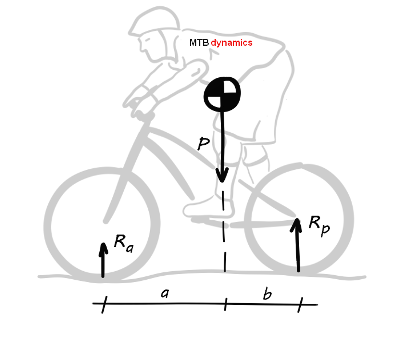
Attack Position
Neutral position, showing the weight applied in the center of gravity and the loads on the two wheels. In this case, the center of gravity is slightly shifted towards the rear wheel.
When starting a descent the position to be taken on a mountain bike is the so-called "attack position" also known as neutral. It gives stability and ensures that the body is ready to react to the roughness of the ground and any obstacles. Let's start by describing the basic position:
- horizontal cranks, at the same height, with the weight equally divided
- slightly bent legs
- lowered saddle and raised bottom
- horizontal and bent forward torso
- spread and bent arms, high and outward elbows
- look forward
- "heavy feet and light hands"
We can say that, due to the equilibrium conditions of a body, the optimal position for the greatest stability is the one with the center of gravity of the bike-rider system in the middle of the support base, which is the segment that joins the two support points of the wheels on the ground.
When the rider offloads his weight exclusively through his feet, and not through the hands also, his center of gravity is vertically aligned with the bottom bracket. This condition is not optimal because the bottom bracket of mountain bikes is not centered between the two wheels, but shifted towards the rear one. It is therefore clear that for the center of gravity to be at the center of the support base, it is necessary to go a little forward, unloading some weight through your hands. That's why we talk about keeping "heavy feet and light hands", that is, unloading most of the weight through your feet and just a little through your hands. This position of the center of gravity guarantees the so-called "centrality" on the bike, which is the starting position to be able to face obstacles and perform momentary unbalancing movements, during which the load is moved forward or backward, as needed.
For any information, to suggest a topic or to simply have your say, find the contacts you can write to.
When the rider offloads his weight exclusively through his feet, and not through the hands also, his center of gravity is vertically aligned with the bottom bracket. This condition is not optimal because the bottom bracket of mountain bikes is not centered between the two wheels, but shifted towards the rear one. It is therefore clear that for the center of gravity to be at the center of the support base, it is necessary to go a little forward, unloading some weight through your hands. That's why we talk about keeping "heavy feet and light hands", that is, unloading most of the weight through your feet and just a little through your hands. This position of the center of gravity guarantees the so-called "centrality" on the bike, which is the starting position to be able to face obstacles and perform momentary unbalancing movements, during which the load is moved forward or backward, as needed.
- How does the weight of the bike (think of e-bikes) or clothing (think of a heavy backpack) affect the center of gravity of the bike-rider system and therefore the basic position ?
- How can we feel that we are not centered on the bike ?
- Going downhill, is it necessary to move the body backward ?
- Why do we strain our arms downhill and how can we avoid it ?
- What are the parameters that affect the need to load the front ?
For any information, to suggest a topic or to simply have your say, find the contacts you can write to.
